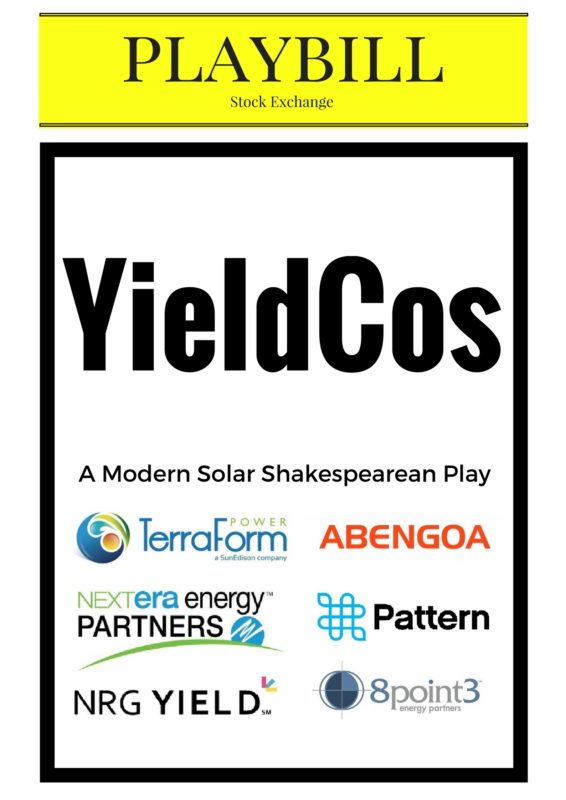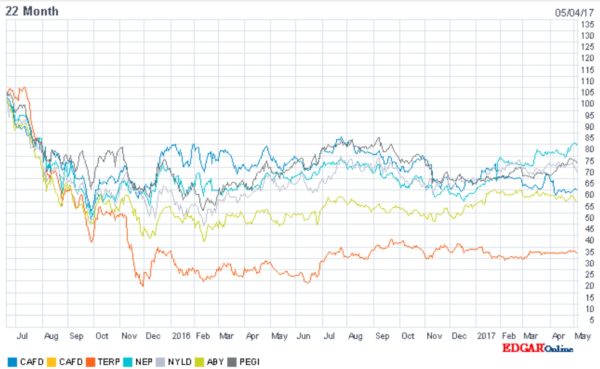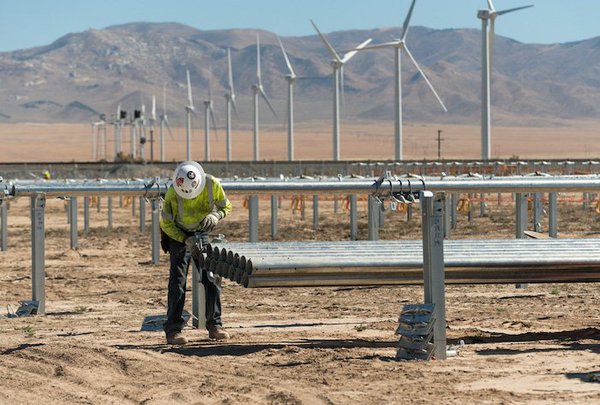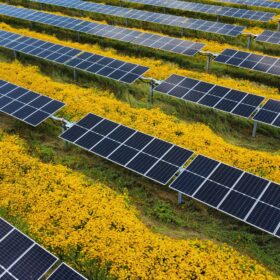By Richard Matsui
Now even NRG may be looking to sell NRG Yield, a top five YieldCo. With NRG under pressure to cut costs, this news stokes growing concerns about the future of YieldCos. Last month solar industry analysts had a field day when First Solar announced it would explore a sale of its stake in 8point3 (CAFD), declaring YieldCos a “losing proposition,” “dividend trap,” and “dead structure.”
 This open punditry reminded me of The Tempest, which I last read in middle school. The Tempest was my first introduction to Freytag’s Pyramid, a ‘data visualization’ of the classic Shakespearean narrative. Across comedies, tragedies, and historical plays, Freytag’s Pyramid identifies the structural similarity of plots and maps them into five acts: Exposition, Rise, Climax, Fall, and Dénouement.
This open punditry reminded me of The Tempest, which I last read in middle school. The Tempest was my first introduction to Freytag’s Pyramid, a ‘data visualization’ of the classic Shakespearean narrative. Across comedies, tragedies, and historical plays, Freytag’s Pyramid identifies the structural similarity of plots and maps them into five acts: Exposition, Rise, Climax, Fall, and Dénouement.
The YieldCo story follows an identical plot line. With leading YieldCos 8point3, TerraForm Power, NRG Yield, and NextEra Energy Partners down over the past few years, many industry watchers seem to be (understandably) caught up in Act IV of the YieldCo story and have not yet considered Act V. First, here are my cliff notes on Acts I-IV:
Act I, Exposition: The year is 2012. Enter our protagonist, YieldCo, a young, independent power producing (IPP) company created to own and operate solar assets in order to generate a predictable cash flow. By separating the development activities (a risky activity) from the long-term asset ownership (a more stable risk) into two different companies, YieldCos democratized investor access to solar assets.
Act II, Rise: As hoped, YieldCos fulfill their initial promises and provide their investors reliable dividend checks. Sensing an opportunity, a YieldCo begins to promise both steady dividends and rapid growth. Thus begins a virtuous cycle: Investors expect YieldCo dividends to grow rapidly, causing investors to bid up the YieldCo stock price, which enables the YieldCo to buy more dividend-generating assets with its valuable stock, which then increases the expected dividend growth, and so on. Through 2013 and 2014, at least 15 YieldCos go public.
Act III, Climax: At their peak, market valuations of leading U.S. YieldCos include TerraForm Power at $5.5B, NextEra Energy Partners at $4.4B, NRG Yield at $4.1B, Abengoa Yield at $3.9B, TerraForm Global at $2.6B, Pattern Energy at $2B, and 8Point3 at $1.3B. By mid-2015, YieldCos are valued at $20B+, a princely sum worth much more than all publicly-listed solar panel manufacturers worldwide.
But stock prices of these sustainable energy companies had been bid to a point of unsustainability. Theories diverge on the exact cause, but no one disputes that during “the Summer Shock of 2015,” the self-reinforcing cycle of high growth and high yield collapses.
This brings us to what many believe is the end of the YieldCo story.
Act IV, Fall: The cycle changes from virtuous to vicious. Within months, share prices fall by as much as 60%, producing widespread investor concern over the function, transparency, and durability of YieldCos.

Two years later, the stocks still haven’t recovered. Just a few weeks ago, First Solar and Abengoa explored selling their respective YieldCo stakes in 8Point3 Energy Partners and Atlantica Yield. Amidst the headlines predicting doom, many industry observers are understandably mistaking this act as the end of the play.
But, as Freytag observed of plays, so too, can we observe of industries: this financial vehicle may be new to solar, but YieldCos are not a new financial vehicle. And neither is this story arc.
Act V, Dénouement: Traditionally, conflicts are resolved in the fifth act: the protagonist either dies or matures, having learned a few life-changing lessons.
YieldCos, as a structure, have not died—the decline of growth-focused YieldCos does not diminish the YieldCos’ original value proposition of separating risky development activities from less-risky, long-term asset ownership. Instead, we are witnessing the maturation of the YieldCo model, and along with it, the maturation of capital deployment into solar.
In the heyday of the growth-focused YieldCo, many investors believed that the YieldCo structure was the single ‘natural owner’ of all renewable assets, and all forms of investment risk. The YieldCo from Act II owned all risks of the operating asset, including the risk of offtaker default, O&M risk, weather risk, etc. Driven by their aggressive growth expectations, YieldCos even assumed a level of development risk, pushing past any cautious objections. These YieldCos were true generalists.
The “Summer Shock” left a vacuum of capital that sparked a Cambrian explosion of new, specialized sources of capital that are the true ‘natural owners’ of specific risks. Power traders, the intellectual descendants of Enron, are rapidly developing hedges that ‘own’ the risk of fluctuating wholesale power prices. Energy management firms like Altenex are developing new contract structures that enable large, investment-grade corporates to ‘own’ the credit risk. At kWh Analytics, we partnered with insurers that rely on our vast data repository of solar asset performance (fast approaching 200,000 operating solar projects) to create an insurance product that ‘owns’ solar production risk. This specialization allows each capital type to play to its unique strengths.
Similarly, we think YieldCos will specialize. YieldCos are modeled after REITs. Today, it is rare for a REIT to be a generalist. There are REITs that specialize in owning strip malls in the Midwest, and others that specialize in owning A-grade office buildings on the coasts. It doesn’t take much imagination to envision a YieldCo that will specialize in distributed solar while another specializes in utility-scale. And no YieldCo should take on development risk again. Put another way, YieldCos are to REITs as West Side Story is to Romeo and Juliet. Different names, same story.
This specialization is ultimately good for the industry. While the fall of growth-focused YieldCos left many investors shaken, managed and financed correctly, YieldCos still have the potential to provide investors with steady yields, project developers with access to capital, and consumers with cheaper solar.
Richard Matsui is Founder and CEO of kWh Analytics, a big data analytics firm aggregating PV performance data to underwrite new insurance policies for solar asset owners.
The views and opinions expressed in this article are the author’s own, and do not necessarily reflect those held by pv magazine.
This content is protected by copyright and may not be reused. If you want to cooperate with us and would like to reuse some of our content, please contact: editors@pv-magazine.com.








This is one of my favorite solar articles to date. Please keep the good crossover content coming!
Thank you! KWh Analytics also does great interviews, and we’ve been publishing those as well.